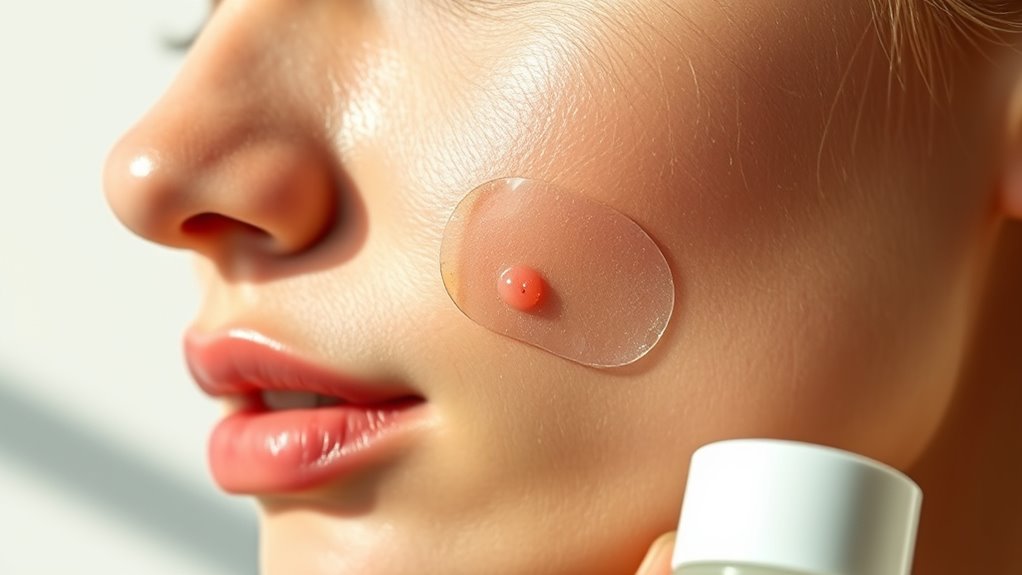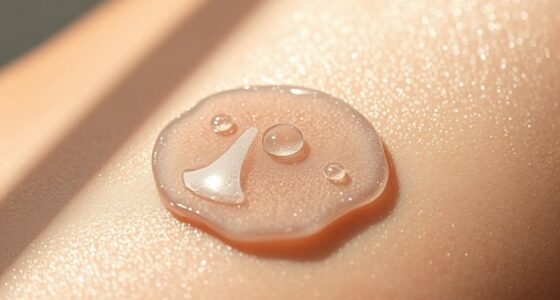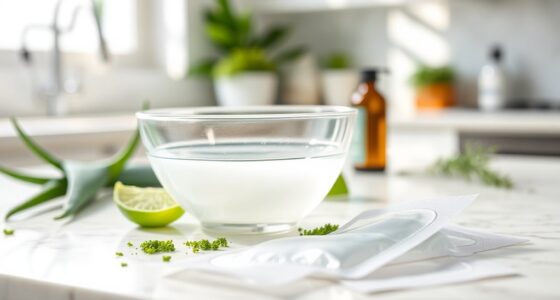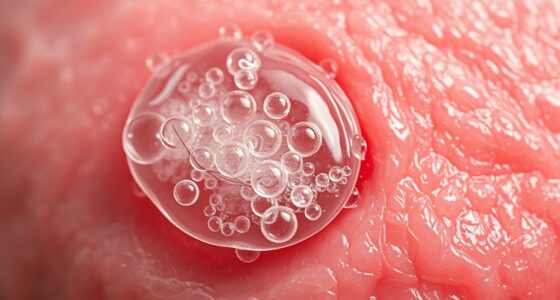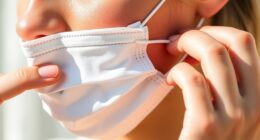You should keep pimple patches on for about 4-8 hours for ideal results. Overnight use of 8-12 hours is common, especially for stubborn pimples that may need up to 24 hours. Just watch for signs that indicate it’s time to remove the patch, like when it turns opaque or feels discolored. Remember, proper application and timing can enhance effectiveness. If you want to know more about the best practices for using these patches, keep exploring!
Key Takeaways
- Hydrocolloid patches should be kept on for 4-8 hours for optimal results, with overnight use recommended for 8-12 hours.
- Stubborn pimples may require patches to remain for up to 24 hours, but replace if saturated.
- Signs it’s time to remove the patch include it turning opaque, swelling, peeling, or causing skin irritation.
- Avoid leaving patches on for more than 10 hours to prevent potential skin irritation.
- Always apply patches on clean, dry skin for better adhesion and effectiveness.
Understanding Pimple Patches: What They Are and How They Work

Pimple patches are a handy skincare solution designed to tackle pesky acne lesions effectively. These small, adhesive patches absorb excess oil and pus, creating a protective barrier that promotes healing.
You’ll find various types, including hydrocolloid, medicated, and microneedling patches, each catering to different needs. Hydrocolloid patches are excellent for absorbing fluids from whiteheads, while medicated ones contain ingredients like salicylic acid to fight bacteria and reduce inflammation.
They’re especially beneficial for oily and acne-prone skin since they keep the area moist without causing dryness. Hydrocolloid patches are ideal for whiteheads and can effectively flatten them overnight. When used correctly, pimple patches can expedite healing, minimize redness, and protect against external irritants, making them a convenient addition to your skincare routine.
Optimal Duration for Pimple Patch Use
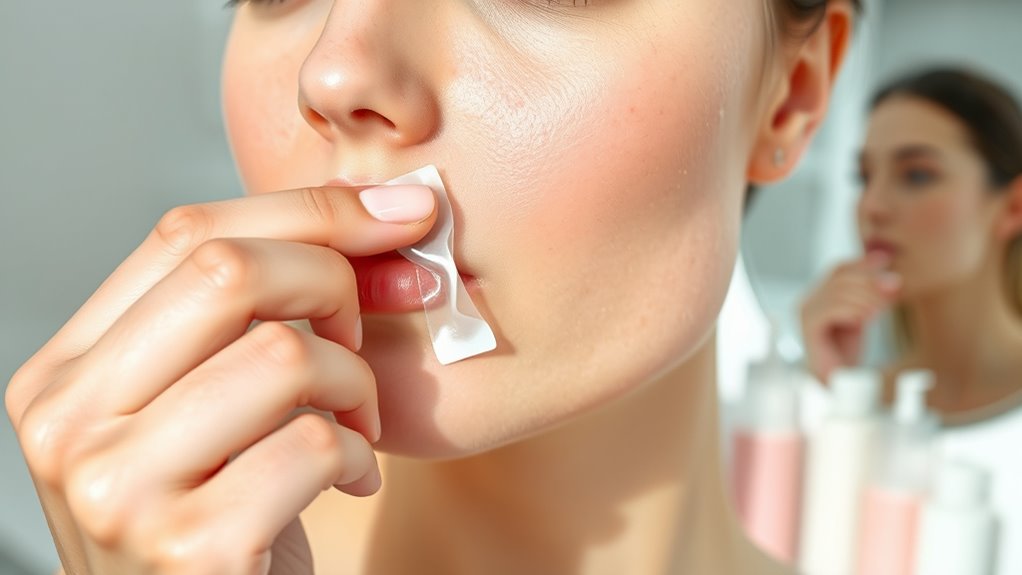
When it comes to using pimple patches, knowing the ideal duration can greatly enhance their effectiveness. Most hydrocolloid patches work best when left on for 4-8 hours, though overnight use for 8-12 hours is common and beneficial. For stubborn pimples, you might even wear them for up to 24 hours, but remember to replace them if they become saturated. Hydrocolloid technology creates a protective barrier over blemishes and helps speed up healing.
Knowing the ideal duration for pimple patches—4-8 hours or overnight—can significantly boost their effectiveness.
Always apply patches to clean, dry skin for maximum adhesion and absorption. Factors like your skin type and the specific patch formulation can influence how long you should keep them on. Following brand recommendations and monitoring your skin’s response will help you achieve the best results while minimizing irritation.
Signs It’s Time to Remove Your Pimple Patch

Knowing when to remove your pimple patch is essential for achieving the best results. Look for visual indicators like the patch turning opaque or white, signaling it’s absorbed all it can. If it feels swollen or has discolored, it’s time to take it off. Additionally, hydrocolloid patches are particularly effective on popped pimples to aid in healing, making it crucial to monitor their condition.
Physically, if the patch starts peeling or the skin around it feels irritated, don’t wait any longer. Increased sensitivity, like itching or a burning sensation, also suggests it’s time to go.
Remember, don’t keep patches on for more than 10 hours to avoid irritation. After removing, cleanse the area gently, hydrate with a moisturizer, and consider reapplying if needed.
Prioritize your skin’s health, and follow these signs for ideal results.
Types of Pimple Patches: Which One to Choose

Choosing the right type of patch can greatly impact how effectively you treat your acne.
Hydrocolloid patches are excellent for absorbing fluid from surface-level pimples like whiteheads, providing a moist environment for quicker healing. Additionally, pimple patches are designed for targeted, convenient, and discreet treatment of breakouts.
Hydrocolloid patches effectively absorb fluid from whiteheads, creating a moist environment that accelerates healing.
If you’re dealing with early-stage pimples, medicated patches infused with salicylic acid or benzoyl peroxide target bacteria and inflammation, but wear them for a shorter time to avoid irritation.
For deep cystic acne, microneedling patches deliver active ingredients deeper into the skin, though they may require longer wear.
Silicone and hydrogel patches are comfortable and great for sensitive skin, while combination patches blend different components to tackle various acne types.
Choose based on your specific needs for the best results.
Application Tips for Maximum Effectiveness

To achieve the best results with pimple patches, start by preparing your skin properly and applying the patches correctly.
Cleanse your skin thoroughly, then pat the area dry to make sure the patch adheres well. Avoid heavy moisturizers right before application, as they can hinder adhesion. Choose a patch that covers the pimple and a little surrounding area for best results. Once applied, press down lightly with your fingers for 20 to 30 seconds. Aim to keep hydrocolloid patches on for 6 to 8 hours, preferably overnight. Proper timing increases the chances of noticeable results by morning, so avoid touching the patch to prevent introducing bacteria. Using patches that contain salicylic acid can further enhance their effectiveness in treating blemishes.
If it starts to peel, press down on the edges. Replace it as needed to maintain continuous treatment.
The Role of Active Ingredients in Pimple Patches
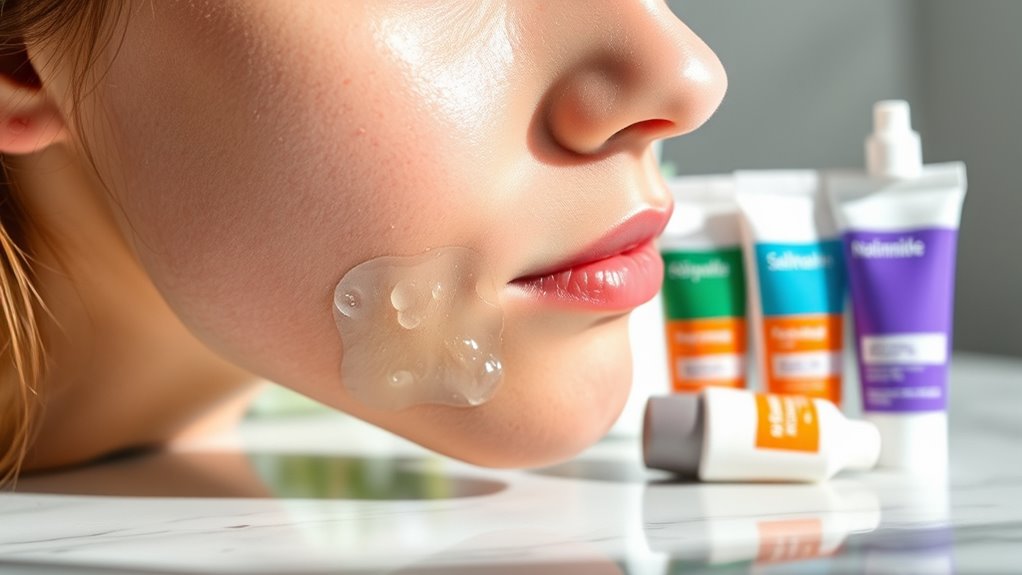
Active ingredients play an essential role in the effectiveness of pimple patches, as they target acne through various mechanisms.
For instance, salicylic acid helps unclog pores and exfoliate the skin, while benzoyl peroxide acts as an antiseptic to kill bacteria. If you’re dealing with inflammation, you might find tea tree oil beneficial, known for its drying properties. Medicated patches contain these active ingredients and are particularly effective for more severe blemishes. Additionally, incorporating ingredients like glycolic acid can enhance exfoliation and promote cell turnover for clearer skin. Hydrocolloid patches, which are known for their moist healing environment, work by absorbing excess oil and promoting a moist healing environment. If you have sensitive skin, consider patches with niacinamide, which enhances skin tone without significant irritation.
Each ingredient serves a purpose, so understanding your skin type and specific needs is vital for selecting the right patch. This guarantees you get the best results from your pimple patches.
Expected Results: What to Anticipate
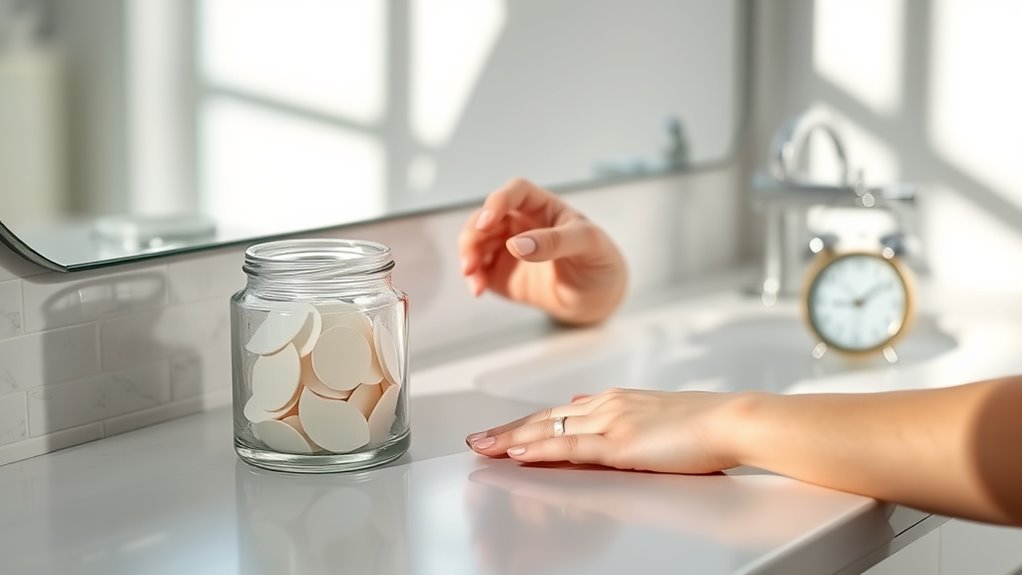
Using pimple patches can lead to impressive results, especially when you know what to expect. You can anticipate fast healing, with pimples flattening considerably within hours. These patches absorb excess oil and pus, reducing redness and inflammation. By acting as a barrier, they prevent you from picking at blemishes, minimizing the risk of scarring. They work best on surface-level acne, like whiteheads and blackheads, but won’t help with cystic acne. Hydrocolloid materials create a moist environment that speeds up healing and absorbs excess fluids. If you apply the patch overnight, you’ll often see noticeable improvements by morning. Just remember to leave them on for at least six hours for ideal results, and replace them when they become opaque. With consistent use, you can boost your confidence and soothe your skin.
Best Practices for Using Pimple Patches
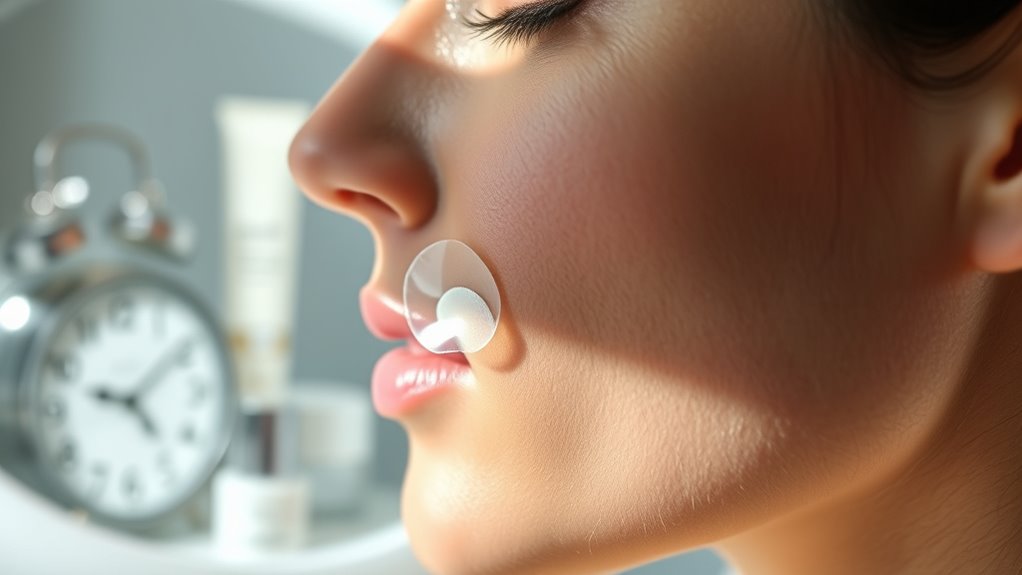
While you might be enthusiastic to stick a pimple patch on your blemish, following best practices can greatly enhance its effectiveness.
Start by thoroughly cleansing your face to remove dirt, oil, and makeup. Pat your skin dry with a clean towel to guarantee proper adhesion. Before applying, make certain there are no leftover skincare products on your skin.
Choose the right patch type based on your acne—whether it’s hydrocolloid or medicated. Apply it immediately after cleansing, ensuring it completely covers the pimple without touching healthy skin. Using clean hands is crucial when applying or removing patches to prevent introducing germs.
Keep your hands clean when applying or removing patches. Finally, remember to wear the patch for 6 to 8 hours, and replace it as needed for continued healing.
Common Mistakes to Avoid With Pimple Patches

Even though pimple patches can be a game-changer for treating blemishes, many people make common mistakes that undermine their effectiveness.
First, make sure to apply patches only on whiteheads, as they work best with visible pus. Avoid using them on cystic acne or blackheads, which don’t yield the same results.
Don’t forget to cleanse your skin before application; oils from other skincare products can prevent proper adhesion. Always place the patch on clean, dry skin for ideal results. Hydrocolloid patches work best on pimples full of fluid, so ensure you’re applying them at the right stage of your blemish.
Also, remove the patch once it turns opaque, and don’t leave it on longer than 24 hours. Finally, never reuse patches, as this can lead to infections.
Choosing the right type and size is essential for success.
When to Seek Professional Help for Acne Issues
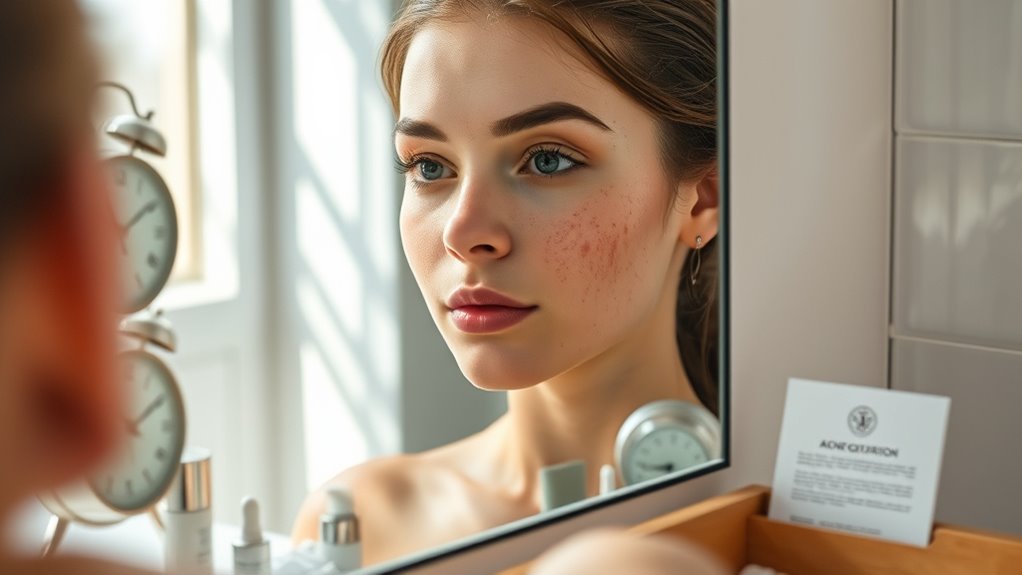
Knowing when to seek professional help for acne issues can greatly impact your skin’s health and your overall well-being.
If your acne persists beyond occasional breakouts or causes physical discomfort, it’s time to consult a dermatologist.
When acne goes beyond occasional flare-ups or causes pain, seeking a dermatologist’s expertise is essential.
When over-the-counter treatments fail to deliver results, that’s another clear sign you need professional advice.
Scarring is a serious concern; addressing it early can prevent permanent marks. Additionally, certain glycolic acid products can aid in improving skin texture and reducing the appearance of scars.
If acne affects your self-esteem or leads to emotional distress, don’t hesitate to reach out for help.
Conditions like cystic or nodular acne require specialized treatment, as individualized care is crucial for effective management.
Frequently Asked Questions
Can I Use Pimple Patches on Sensitive Skin?
Yes, you can use pimple patches on sensitive skin, but you need to be cautious.
Start with non-medicated hydrocolloid patches to minimize irritation. Always do a patch test first to check for any allergic reactions.
Avoid patches with strong active ingredients like salicylic acid, as they can cause irritation. If you notice redness or discomfort, remove the patch immediately.
Consulting a dermatologist for tailored advice is a smart move too.
How Often Can I Use Pimple Patches in a Week?
You can use pimple patches as often as you need throughout the week, but listen to your skin.
If you have sensitive or dry skin, it’s best to limit their use to avoid irritation. Daily application is fine for most, especially when targeting active breakouts.
Just remember to keep up with your regular skincare routine for best results and replace patches when they become saturated or change color.
Are Pimple Patches Safe During Pregnancy?
Using pimple patches during pregnancy is like finding a safe harbor in a storm.
They’re generally considered safe because they create a protective barrier while drawing out impurities without irritating your skin. Hydrocolloid patches are a non-invasive option for pregnancy acne, which often stems from hormonal changes.
However, it’s wise to consult your healthcare provider before trying any new skincare treatments to guarantee it’s right for you and your baby.
Can I Wear Makeup Over Pimple Patches?
Yes, you can wear makeup over pimple patches! They actually create a smooth surface, making it easier to blend your foundation and concealer.
Just apply the patch to clean, dry skin first, and use a light hand to avoid disrupting it. Opt for matte finish products to help the patch blend in.
Remember to set your makeup lightly to keep everything intact without compromising the healing benefits of the patch.
Do Pimple Patches Work on Hormonal Acne?
You might be surprised, but pimple patches can really work wonders on hormonal acne! They create a protective barrier that keeps you from picking at your skin, reducing irritation.
Plus, they absorb excess oil and pus, helping your pimples heal faster. While they’re not a one-size-fits-all solution, combining them with a consistent skincare routine can enhance their effectiveness.
Conclusion
In conclusion, knowing how long to keep pimple patches on can make all the difference in your skincare routine. Typically, you should leave them on for six to eight hours, like waiting for your favorite show to drop a new season. Just remember to watch for signs that it’s time to remove them, and always choose the right type for your skin. With these tips, you’ll be on your way to clearer skin in no time!
